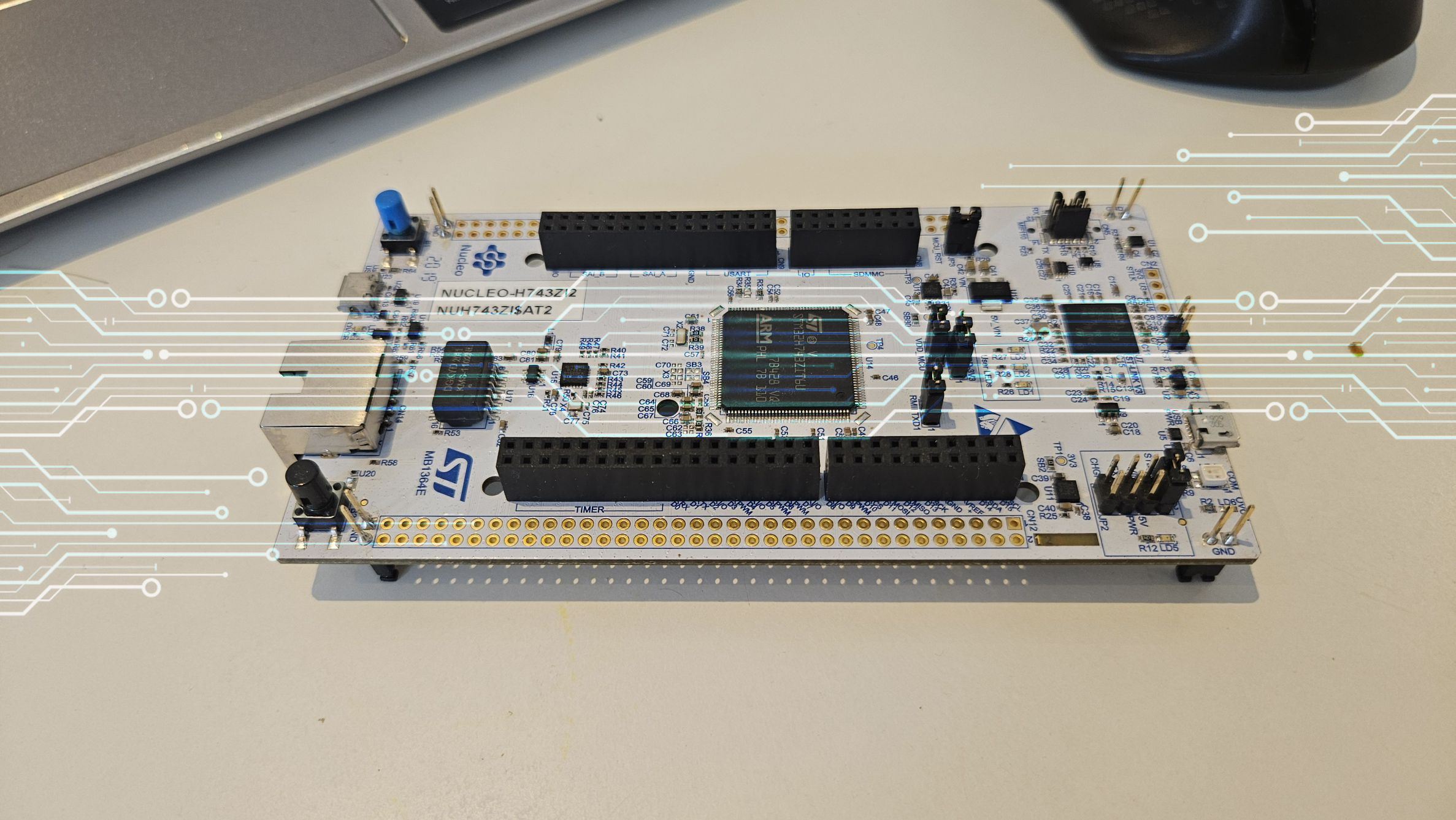I’ve worked with C on microcontrollers and decided to tackle concurrency. Real systems need to sense, react, and present information at the same time, and simple approaches quickly become unmanageable. A Real-Time Operating System (RTOS) is designed to handle that complexity.
The goal was to experience concepts that I heard in lectures (Pre-emptive scheduling, mutex, etc.). I set up a project on an STM32 Nucleo board with the goal of building a “real” application from scratch, moving beyond a simple blinky to implement the core pillars of an RTOS.
Objective
My goal was to demonstrate and master three fundamental RTOS concepts using FreeRTOS on an STM32H7:
- Pre-emptive Multitasking: To have two independent tasks run concurrently without interfering with each other.
- Inter-Task Communication: To create an event-driven system where one task (a button press) can safely send data to another task (an LED).
- Shared Resource Management: To allow two tasks to share a single piece of hardware (the UART serial port) without a race condition, a classic bug where they try to use it at the same time and corrupt the data.
My Contribution
I designed this application using the STM32CubeIDE. My process involved:
- System Configuration: CubeIDE’s graphical tool to configure the MCU’s clocks, GPIO pins (for LEDs and the button), and the UART peripheral.
- RTOS Configuration: Enabled the FreeRTOS middleware (using the CMSIS v2 API) and configured its settings.
- Application Logic: Wrote C code for the three main tasks:
- A simple periodic task for the slow-blinking LED.
- A “producer” task that monitors the user button.
- A “consumer” task that waits on an event to toggle the second LED.
- Debugging: I used the serial port as my console to print status messages and verify that the system was running as expected, especially after implementing the mutex.
Technical Details
- Hardware: STMicroelectronics NUCLEO-H743ZI2 (ARM Cortex-M7)
- Software/Libraries: C, FreeRTOS (CMSIS-RTOS v2 API)
- Toolchain: STM32CubeIDE
- Key Concepts: Pre-emptive Multitasking, Message Queues (Producer/Consumer), Mutexes (Mutual Exclusion), Race Conditions, Thread-Safe Design
Challenges & Learnings
This project had a series of moments that made me recall certain concepts, as I saw RTOS theory come to life in code.
1. Learning: osDelay() is Not a “Pause”
My first step was creating two tasks to blink two LEDs at different rates. The “magic” is the osDelay() function. In bare-metal C, a HAL_Delay() blocks the entire system. In an RTOS, osDelay() is totally different: it’s a message to the scheduler that says, “I’m done for now, put me to sleep and go run another task. Wake me up in 2 seconds.” This is the core of pre-emptive multitasking, and seeing both LEDs blink perfectly out of sync proved it worked.
2. Learning: Queues are Better than Global Variables
My next challenge: how to make one task react to another. The “bad” way is to use a global flag. The “good” way is with a queue.
- Problem: I needed my button-reading task to tell my LED-toggling task to “go.” A global variable is not “thread-safe”, what if the button is pressed twice before the LED task can read the flag? An event would be lost.
- Action: I implemented a FreeRTOS queue. The button task became a “producer,” adding a message to the queue when the button was pressed. The LED task became a “consumer,” spending all its time blocked (sleeping) while waiting for a message.
- Result: This was incredibly powerful. The LED task uses zero CPU time while it’s waiting. As soon as the button task sends a message, the RTOS instantly wakes up the LED task, which runs, toggles the light, and goes back to sleep. This event-driven pattern is the foundation of efficient, responsive design.
3. Learning: The Mutex and the “Race Condition”
This last hurdle clarified a behavior I hadn’t fully understood until then.
- Problem: I had both my LED tasks print a status message to the serial port (UART). The result was a garbled mess, like
Task 1: LED ToggTlaesdk 2: LED Toggled. This is a classic race condition, where both tasks tried to write their data at the exact same time. - Action: I fixed this using a mutex (which stands for “mutual exclusion”). A mutex is a “lock” that only one task can hold at a time.
- Result: I wrapped my UART print statements in a
osMutexAcquire()andosMutexRelease()block. Now, when Task 1 wants to print, it takes the lock. If Task 2 tries to print, the RTOS sees the lock is taken and automatically puts Task 2 to sleep. When Task 1 is done, it releases the lock, and the RTOS wakes Task 2 up to finally print its message. The output became perfectly clean, and I had a tangible, real-world example of how to protect shared resources.
This project was the perfect step up from bare-metal programming. It solidified my understanding of why an RTOS is so critical for building any embedded system that is complex, responsive, and reliable.
